The new Age of Sigmar has been released and excitement over the game has been quite positive. Gamers of all stripes have more tools than ever to experience the (now) rich lore of the game. Narrative gamers in particular have enough material to fill decades of weekly gaming sessions. This week, Loopy (Adam from the Masters of the Forge podcast and T.O. of the Goldensprue Cup GT) will be diving into the different ways to play your narrative games as presented in the new edition.
For this article, we’ll take a shallow dive into each of the game types presented in the Core rulebook, the General’s Handbook, and the Malign Sorcery book. My general advice, as you read, is to look at each one of them as a single lever in the campaign machine. They do not have to be used independently of each other. You don’t have to run a Aerial Battles campaign or a Gathering of Might campaign. Each game type can serve a bespoke purpose in your campaign. Have a look at the “Beneath Skull Mountain” spread on pages 290 and 291 of the Core Rulebook to see what I mean. The campaign detailed in this article doesn’t use the loose progression rules on those pages, but you’re free to experiment with them and do what you like. This is Narrative Play after all.
Example Campaign
Throughout this article, I’ll be using two armies in my examples to add meat to the concepts we discuss and to show a growing narrative.
The Seething Pestilence
The Plague Priest Kkiziail has assembled a group of Clan Pestilens Skaven along with an assortment of Nurgle Daemons and Deadwalkers all bent on the spreading of disease. Kkiziail was just beyond the epicentre of the Necroquake when it went off and the mighty rush of power that he observed in its wake has inspired him to greater works of defilement. Remember that in Narrative Play, the allies matrix is more of a guide than a rule.
The Cursed Children of Sigmar
The Cursed Children are a Conclave of the Anvils of the Heldenhammer Stormcast Eternals. They are loyal to Sigmar and champions of humanity in their own right, but as former denizens of the Realm of Shyish, do not relish in the gift of eternal life that has been given to them. In fact, they tend to look upon their benefactor with some measure of scorn. The Cursed Children are led by Lord Celestant Cora Quickgrave.
A Note on Characters
The Lord Celestants and Plague Priests are great choices for this narrative campaigns because they each have different models and mounts they can use to represent their presence on the battlefield in different ways. For example Quickgrave can be deployed on foot in smaller games, or on a Stardrake in larger games or in an Aerial Battle. I recommend using characters such as these in your ongoing narrative campaigns so that you can maintain a storyline with them and yet add variety to your games.
The Battle of the Rarregh Realmgate
The Seething Pestilence has been gnawing at the fringes of polite society for too long. They have decided to strike a decisive blow at the a conclave of Order called Rarregh, a city which was built around a Realmgate between Shyish and Ghur. Rarregh and the surrounding environs are affected by the proximity of both realms. On the Ghur side, the region is known as the Graveyard of Beasts. When a colossus falls ill or suffers a mortal injury, it will sometimes spend the remaining days of its life traveling to Rarregh to die in peace among the rest of its kind. The Ghur side of the city is built on the bones of these long-dead creatures. The Shyish side of Rarregh is likewise affected by its connection to Ghur. The city is a haphazard collection of small, stone structures sprawling out from the Realmgate at its center. The chaotic and sometimes confused spirits of dead animals roam the region. For most of these spirits, their tenuous grip on reality is fettered mostly by the memories of the humans that interacted with them in life. Some people have been known to travel for years to come to Rarregh in the hopes of being reunited with a beloved companion. In addition, there are other beasts who boast strong souls in their own right. Most of these latter sort manifest fully in the service of Nagash, but others have managed to shirk this responsibility and instead dwell in the twisted and broken terrain surrounding Rarregh.
The city was long ago liberated by the Anvils of Heldenhammer, but it has not been considered of huge import to the cause, so it has been fortified with a small contingent of human auxiliaries and the Cursed Children of Sigmar. Due to the limited numbers of defenders, Rarregh’s large and sprawling layout on either side of the Realmgate makes the city difficult to defend using conventional means. Instead, the forces of Order focus on memorizing the terrain and streets. When enemies attack, they find themselves harried through the city by a well-drilled foe. By the time any army reaches the Tusked Citadel at the center of the city, their numbers are so badly dwindled that they are no match for the forces assembled there.
Note that it is assumed that, for each scenario example we give here, we will be using the Realms of Battle rules for Shyish and that both armies hail from Shyish. You may wish to say that both Cora Quickgrave and Kkzizail may each choose a different relic from the Shyish list for free.
Ongoing Narratives
Although the Core Rulebook provides an interesting mechanic in the Triumphs table to provide benefits to armies as they succeed in battle, I recommend creating specific consequences for success and failure for your scenarios. I think you will find this far more rewarding an experience for both players.
Narrative Play Special Rules
Unlike the Warhammer 40,000 core rulebook, the one for Age of Sigmar doesn’t contain a number of generic Narrative Play scenarios. The General’s Handbook, however, still does provide us with a large number of special rules we can use to create our own scenarios. I would actually argue that any of the scenarios found within the rulebook (even the Matched Play ones) are a great starting point for your narrative.
Of course, as narrative players, we’ll want to punch these missions up a bit. The rulebook warns us not to use too many special rules in our scenarios. This is good advice. Sometimes a few additional rules to spice things up is all we will need to add some fun flavor without bogging the game down with complication. Having said that, don’t let this advice dissuade you from telling the perfect story. You do what you think is best for your scenario.
In any case, keep two things in mind when choosing your special rules: the scenario and the location. Picking one special rule to affect each of these things should be enough to breathe narrative life into your scenario, though this is not a hard and fast rule.
The Battle for the Valley of the Unforgotten
Kkzizail knows that the the forces of Order will not be easily defeated and certainly not with a frontal assault. The Seething Pestilence has never really been much for that kind of warfare anyways. As such, they represent the first real threat that the Rarregh and the Cursed Children of Sigmar have faced in centuries.
Having said that, Kkzizail also knows that the generals of Shyish are wary of what lies beneath their cities ever since the plans of Nagash were fouled by the machinations of the Skaven. For this reason, Kkzizail has decided to send a portion of his collected might through the Valley of the Unforgotten to assault Rarregh on the Shyish side of the city in a bold and foolish maneuver. Kkzizail does not expect any of his committed forces to survive the encounter, but he hopes that it will distract the forces of Order long enough for him to infiltrate the city from below.
Looking through the scenarios available in the General’s Handbook and the Core Rulebook, we can find one scenario that could work nicely for the Seething Pestilence’s march through the valley: Battle for the Pass. Although it is a Matched Play scenario, it has just the right deployment type for our purposes and the scoring represents each army scoring points based how how deeply they penetrate enemy territory. You should never discount the Matched Play scenarios in Age of Sigmar; they still make a lot of sense from a narrative perspective.
For the scenario of the Battle for the Valley of the Unforgotten, we’ll want a way of showing that the Seething Pestilence is using their attack here as a distraction. Although they would like nothing more than to break through and get to the city themselves, that’s not their primary focus. I would consider using the Sustained Attack rules for the Forces of Order. This rule allows a player to set aside a unit other than a Hero when it is destroyed. This unit can return to play in the controlling player’s movement phase to bring them back into play on a 3+. For this scenario, we will require that the player roll the dice instead of making it an option. Keep track of how many units return to play in this manner and score +1 Victory Point to the Seething Pestilence for each unit that does so.
As to the location, the Valley of the Unforgotten is teeming with the spirits of dead creatures of all kinds. I would use the Wandering Monsters special rule. This is a fun rule which allows you to, when you set up terrain, also set up some wandering monsters which count as an enemy unit to both sides, but won’t move or attack unless another unit moves within 3” of it. Wizards on both sides can cast a Bind Creature spell (provided alongside the special rule on page 23) in order to take control of a wandering monster within 12’ of the caster. Throughout the game, wizards can actually wrest control of these monsters from each other with a successful casting of the spell.
For the purposes of this scenario, instead of individual wandering monsters, the spirits of the dead are probably best represented by packs of Dire Wolves and Gryph-hounds. You may want to impose a +1 penalty to Morale checks for an Order unit which is forced to kill a unit of these lost spirits.
Aerial Battles
Although Aerial Battles are represented as an Open Play concept (and include an Open Play scenario generator), the rules are more than suited for Narrative Play. These rules are quite streamlined from previous similar offerings for either 40k or Sigmar. Although there are specific scenario rules for these types of Aerial Battles, these rules could easily be incorporated into a more generic scenario. You can play Aerial Battles in one of two ways: either Overhead or Stratospheric.
Even in the Overhead scenarios, there is a separate battlefield for flying units. Ground units can still shoot units on the “Overhead battlefield” as long as their weapons have a range of 18” or more, albeit hitting on 6s. Although nothing is said of it, I might also allow some spells to similarly affect flying units. In Overhead battles there are hilarious rules for units on the ground level being hit by the falling bodies of slain models.
Stratospheric battles are very interesting indeed. You lay out terrain to represent the tops of towers where ground units are deployed. There are even rules for models accidentally falling from these high places.
The Harrying of Eagle’s Rest
Kkzizail knows that one of the key strengths of Rarregh (on both sides of the Realmgate) is its air superiority. On the Shyish side of the city, the tower of Eagle’s Rest is guarded by the mighty avian ancestor spirit, Hakkaaan. The soul of Hakkaaan was reforged long ago as a Stardrake and, in times of trial, serves as a mount for the Lord Celestant Cora Quickgrave.
Upon this mighty bulwark, even if the city is surrounded on all sides, the Kharadron Overlords can still convey materiel to the city, thus allowing the population to, in theory, ride out a siege indefinitely. For this scenario, we will place a large hill with a citadel on it in the center of the battlefield to represent the pinnacle of Eagle’s Rest. The remainder of the battlefield will be empty sky using the Stratospheric Aerial Battle rules.
The point of this scenario is simple domination of the citadel itself. Large models, however, should dominate over any single model in the control of this objective, of course. For this reason, the winner of this scenario should be the player with the most wounds represented on the Eagle’s Rest at the end of the game with any Heroes counting for double.
For this scenario, let’s choose a narrative play rule to represent the haphazard attack methods being employed by a General who, if we’re being honest, really isn’t used to aerial tactics. Moreover, the defending forces weren’t expecting such tactics to be employed either. The Fog of War rule is a fun way to mess with deployment, forcing players to deploy their army in a random part of the battlefield. The defender, however, should be allowed to deploy any of their ground units in the Eagle’s Nest itself at the centre of the battlefield.
For the battlefield, instead of choosing a narrative play rule, why not keep things interesting and randomly generate an effect from the Aerial Battles Twist Table. Note that you should probably grant any Stormcast units an additional save against lightning strikes.
Darkest Depths
The Core Rulebook contains some fairly serviceable rules that 40k players might call “Zone Mortalis for Sigmar”. These rules are uncomplicated and thematic. For example, you can’t fly and the ranges of missile weapons are decreased to a maximum of 12”. Note that these rules are not supposed to represent giant caverns, but tunnel networks and catacombs. You can also choose to add a neutral monster to the battle or introduce unstable surroundings that can cause mortal wounds.
Interestingly, Darkest Depths also includes some unique Command Abilities that both players can use; among these are Hazardous Traps, Hidden Tunnels, and Tame the Raging Beast. This sets an incredible precedent. In Warhammer 40,000, the stratagems for unique Narrative scenarios are part of what makes them so fun. It’s harder to break a scenario with powerful rules if those rules are only accessible with a limited resource.
I am very much looking forward to what other ways Games Workshop uses the Command Ability mechanic to tweak not only scenarios but also factions going forward.
Sapping the Tusked Citadel
It should come as no surprise that the Skaven clans have long since held a presence in the catacombs beneath Rarregh. It is a tenuous presence, though, for it is still a place of the restless dead and the forces of Order have cordoned off the corridors and chambers beneath the Tusked Citadel itself. It is this area the Seething Pestilence seeks to claim.
Use the deployment map for the Underground Ambush on page 301 of the Core Rulebook, but not the victory conditions. The Attacker wins the game if they are able to use the Hazardous Traps Command Ability four times before the end of the fifth battle round.
Although Darkest Depths already uses some rather unique rules, as narrative gamers we have a hard time not tinkering with things. There are still many narrative play special rules which would be appropriate for this setting. I suggest using the Concealed Deployment rules for this scenario. The rulebook suggests either setting up an actual physical barrier to hide models (like covering them with a light sheet or paper) or drawing their general location on a map. You could also use numbered “blips” including “dummy blips” to confuse your opponent. You could even move the blips throughout the dungeon until your opponent finally makes contact with them. If you’re asking yourself “How do I know my opponent isn’t cheating by moving their blip faster than the actual unit can move?” then narrative gaming probably isn’t for you… or at least your regular opponents.
Siege Warfare
The Core Rulebook provides some guidance for Sieges in your games of Age of Sigmar. These rules are much more than just ways to fight using lots of big scenery (although that is certainly part of the appeal), there are also rules for adjudicating an extended engagement.
The game is set up as you’d expect, with the defender placing loads of terrain in their deployment zone and the attacker setting up their army opposite that in a wider, more open deployment. What’s really interesting is that next comes the Siege Phase.
In the Siege Phase, the attacker will do three things: Starve, Batter, and Tunnel against their opponent. Starvation deals mortal wounds to each enemy unit, Battering ruins terrain features, and Tunneling allows the attacker to remove models from their army and “deepstrike” them throughout the game.
The success or failure of these actions is dependent on which of these paradigms the attacker and defender focus on. The attackers can choose either Starve, Batter, or Tunnel as their primary siege tactic. The defender can choose to either Gather Supplies, Re-Build, or Counter-tunnel as their counter siege tactics. Each player secretly chooses their primary tactic and a table determines how these tactics will affect the Starvation, Battering, and Tunneling rolls.
Furthermore, Siege Warfare includes special Command Abilities that are unique to these types of scenarios. The attacker can plant demolition charges and recycle units as reinforcements. The defender can reroll charges for units that disembark from terrain features and gain extra defense from hiding in terrain.
The Siege of the Tusked Citadel
The time has come for Kkzizail to strike a decisive blow against the Tusked Citadel of Rarregh. If all has gone well in the previous scenarios, the forces of Order will be hard pressed to hold back the teeming hordes of Skaven and slavering zombies.
If the Seething Pestilence won the Aerial Battle, the defenders have lost their supply chain and may not choose the Gather Supplies tactic. If the Seething Pestilence won the Darkest Depths scenario, then the defenders have been routed from the catacombs and may not choose the Counter-tunnel tactic. If the Seething Pestilence won the Battle for the Valley of the Unforgotten, then they were able to blitz the city with enough speed that there was no time for the defenders to use the Re-build tactic. In this way, if they lost all their previous games, they may not choose any tactic whatsoever.
Note that the citadel is the location of the Realmgate to Ghur and, as such, it would make sense to have a Realmgate terrain feature along the Order player’s battlefield edge.
In this scenario, we are trying to represent the Cursed Children of Sigmar and what remains of their human auxiliaries holding the citadel against the teeming hordes of Skaven, Plaguebearers, and Zombies. These elite warriors must be given their due in such a scenario and their commander, Cora Quickgrave has been at the center of the entire conflict. As such, we will use the Rising Star rule for this scenario. This rule allows a player to choose one of four abilities for their General, either Battlefield Strategery (+1 command point per turn), Heroism (extra attacks), Leadership (share Leadership for Bravery), or Martial Prowess (reroll hit rolls). For our scenario, let’s break the rules a little and allow Cora to pick one of these for each game the forces of Order have won previous to this one.
For this battlefield, it might make sense to use the Tunnel Network narrative special rule to represent the catacombs beneath the city. This rule allows units to “teleport” from one terrain feature to another. Only the winner of the Sapping of the Tusked Citadel may use this rule.
As to the victory conditions, I would say the Realmgate on the defender’s battlefield edge should be worth 5 victory points at the end of the game while all other significant terrain features are worth 1 each. A unit can claim a terrain feature as if it were any other objective, except they do so by counting models within 1” of the feature instead of 6”.
Gathering of Might
A 40k player might say that Gathering of Might is “Apocalypse for Sigmar” and that is an apt comparison. These rules are intended to be used for huge games of Warhammer and include notes about time limits for deployment and game turns.
The coolest thing about Gathering of Might, however, and what makes it unique to Apocalypse, is the epic scale that is brought to bear in the experience. The players have access to Legendary Abilities, Legendary Traits (for the General), Gifts of the Gods (a once per game super-ability), Legendary Artefacts (super Relics), and Legendary Spells. All of these would be somewhat overpowered (but not really game breaking) if used in regular games of Age of Sigmar.
Note that you don’t want to add too many special rules to a Gathering of Might game that you want to finish in a single day. If you can leave the game set up all week and play over the course of a few days, then by all means go ahead and pile on the special rules. Keep in mind, however, for your first game using these rules that there will be a great deal that is new to the players that they’ll have to remember.
Although the sample scenarios for Gathering of Might do include victory conditions, it is important to remember that winning and losing by points isn’t really important for these kinds of games. Instead, focus on the goals of the characters involved and what happens on the battlefield. If you keep that in mind, then the narrative should develop naturally.
The Tide of Blights
The Tusked Citadel has been overrun by a plague of diseased Skaven, Daemons, and Zombies. The heroes of Order have fought and died in order to hold back these ravenous hordes. The desperate battle balances on a razor’s edge and relief comes from an unlikely ally.
In this final battle, if the forces of Kkzizail won the Siege of the Tusked Citadel, the Realm used will actually be Ghur instead of Shyish. This represents the tide of filth flowing into that side of the city through the captured realmgate. If the forces of Order won the last battle, this represents their final stand against the remains of a weakened foe on the Shyish side.
For this scenario, the forces of Order will receive aid from the bestial spirits of Ghur for they do not take kindly to the unnatural predation of the Skaven and Nurgle. All Ravenak’s Gnashing Jaws endless spells cast by the forces of Order are always under their control, even if they take the first turn in a round.
If the battle is fought on the Ghur side of the city, then use the Wild Magic narrative play rule. This subtracts 2 from all unbinding checks.
Furthermore, the machinations of Kkzizail have not gone unnoticed by the forces of Nurgle and Nagash. Use The Great Game narrative play rule for this scenario, except that the effect is always “Boon of Nurgle” and it only affects the attacking forces. Furthermore, Kkzizail may select an additional artefact for this battle as described in the A Gathering of Power narrative play rule, but they must choose from from the Artefacts of Death from page 253 of the Core Rulebook.
Other Methods of Narrative Play
Open War: It can be quite rewarding to, instead of conducting a narrative, allow the narrative to happen to you. With the Open War deck, you can randomly create scenarios and allow your imagination to decide what kind of narrative that assortment of cards actually represents.
Triumph & Treachery: The rules for multiplayer games can be plugged into almost any type of scenario. They simply adjudicate turn and phase order in an equitable fashion for multiple players. I recommend doing a few Open Play versions of this game type before trying to weave a narrative with them.
Malign Sorcery: There are several cool scenarios available in the Malign Sorcery book with special rules that should get your creative juices flowing. There are even some scenario-specific Command Abilities that you should make note of.
Skirmish: Rules for Skirmish are available separately and there are some supplemental rules available for it in Malign Sorcery. I would assume that an update for these rules will be forthcoming.
Wow!
That article ended up being a lot more involved than I’d originally intended, but I did enjoy writing it. Please let me know your feelings on it in the comments below. I think I have one more of these in me before I move on to more 40k content.
Did you like that article? If so, you can check out the previous ones in this series…
Narrative Gaming in the Age of Sigmar discusses the stories you can tell with the new edition and how the lore has developed over time.
Age of Sigmar Narrative Gaming – Realms of Battle focuses on playing in each of the different Mortal Realms. We specifically talk about the rules for each of these locales.
Please be sure to check out the Masters of the Forge. We’re the podcast that brings the rich lore of Warhammer 40,000 to life on your tabletop. Also, please consider attending the Goldensprue Cup GT each January in upstate NY.
And remember, Frontline Gaming sells gaming products at a discount, every day in their webcart!

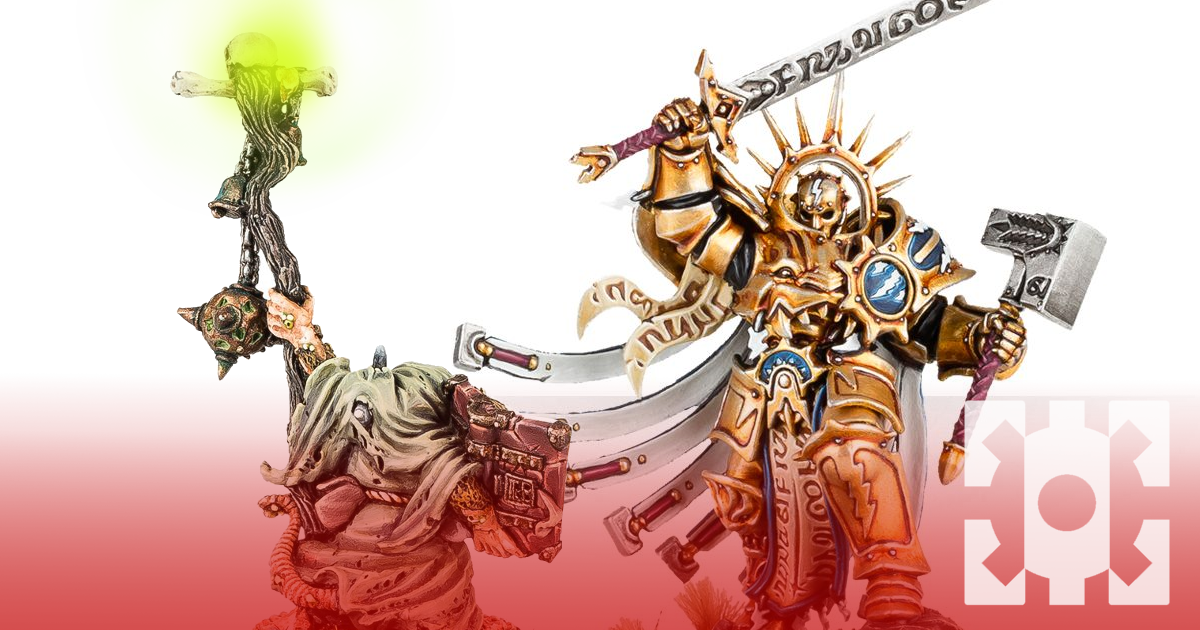
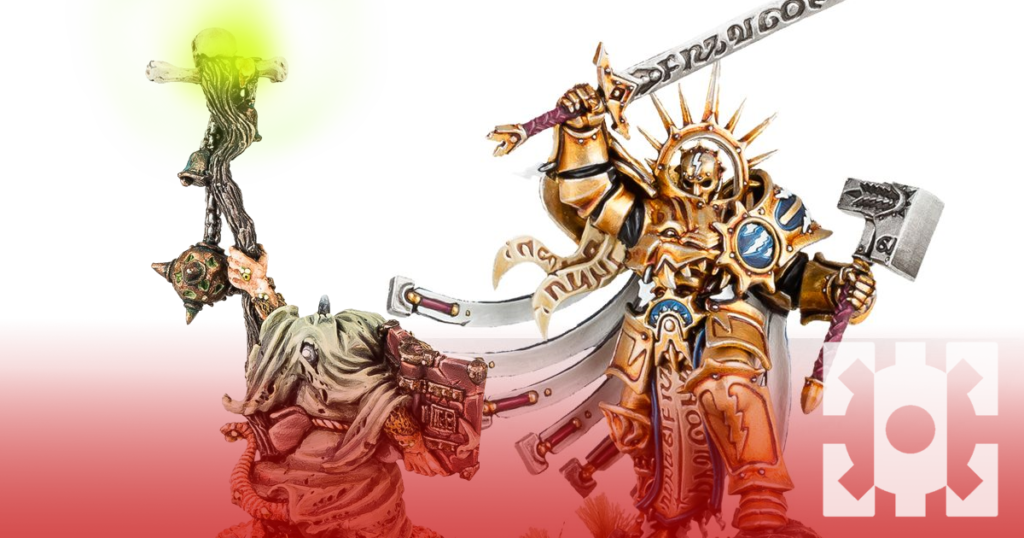
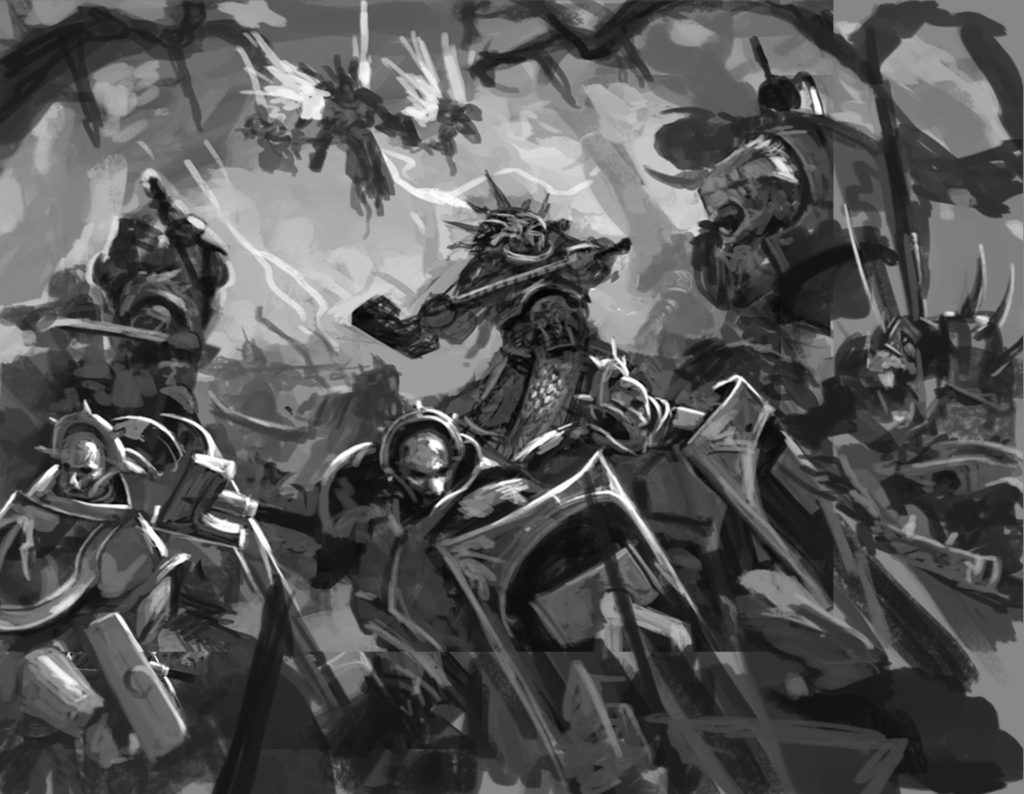
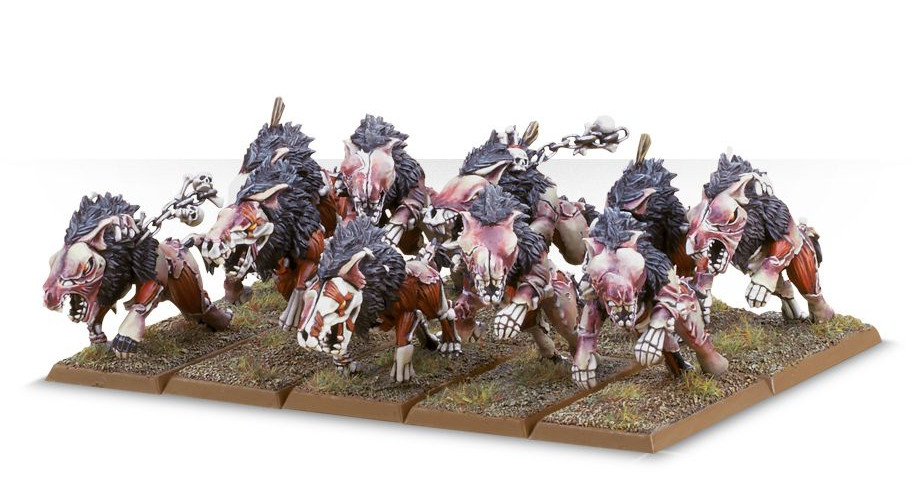
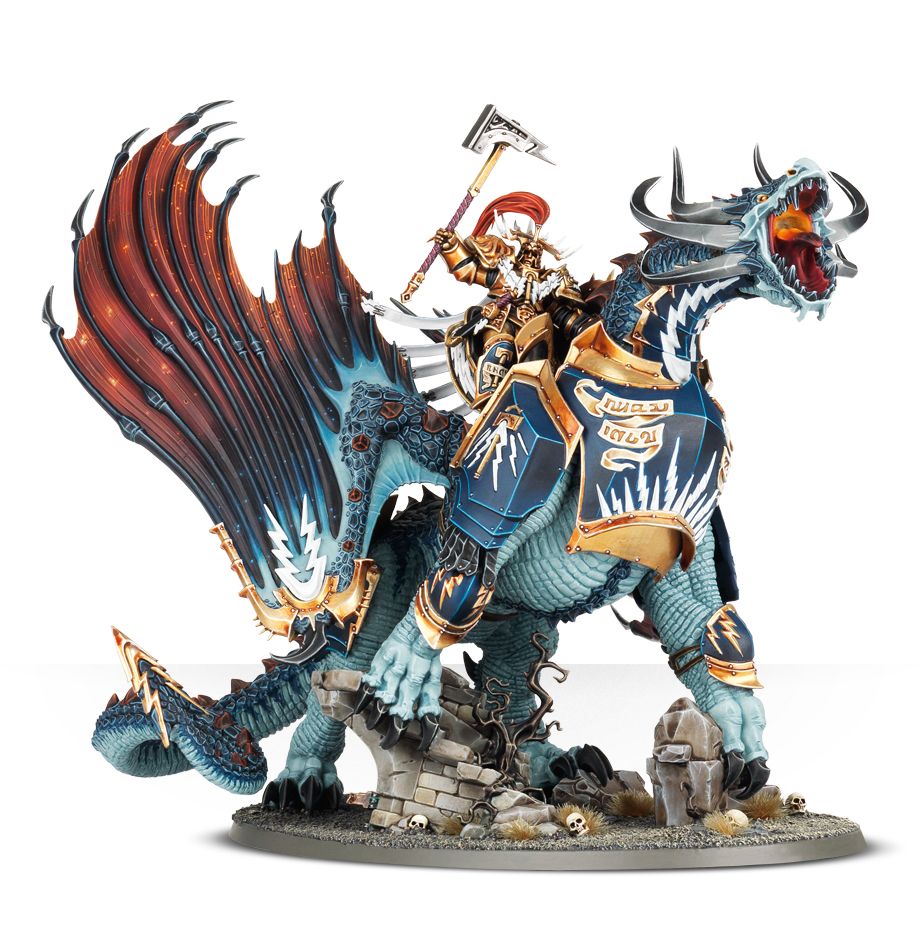
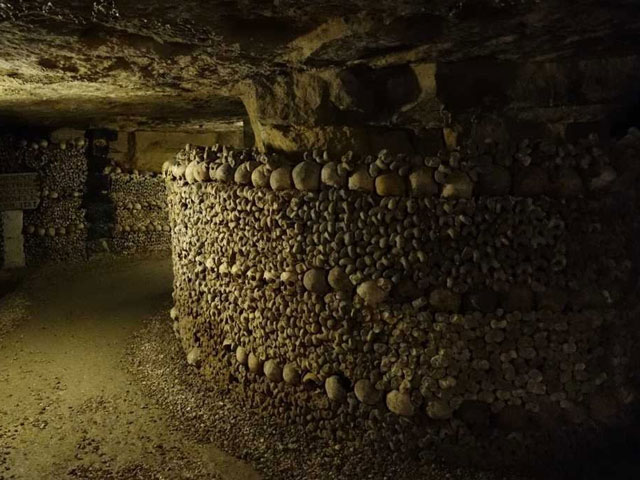
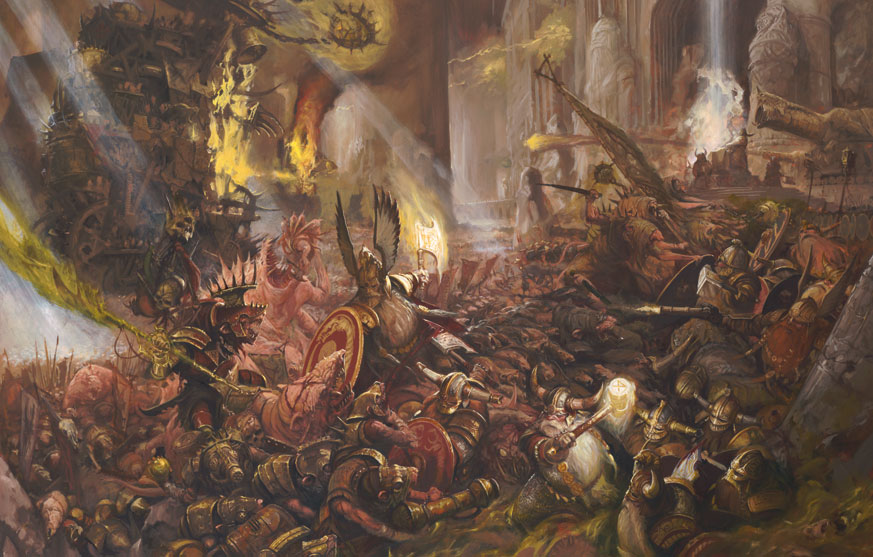
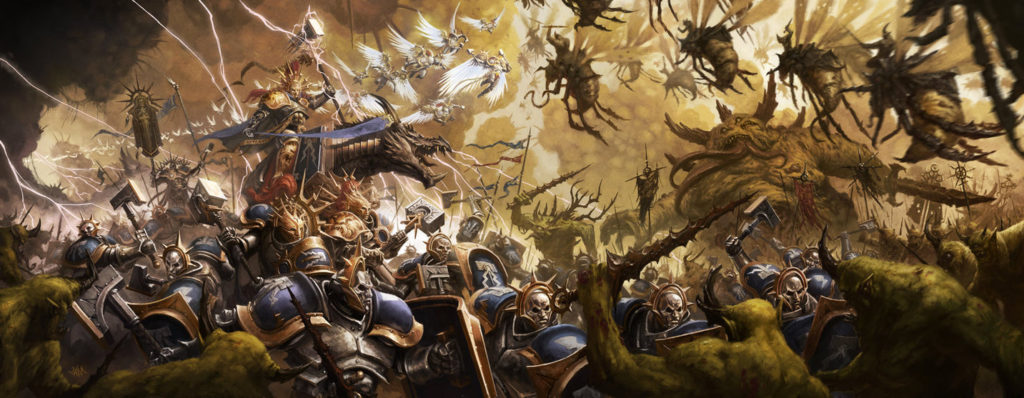
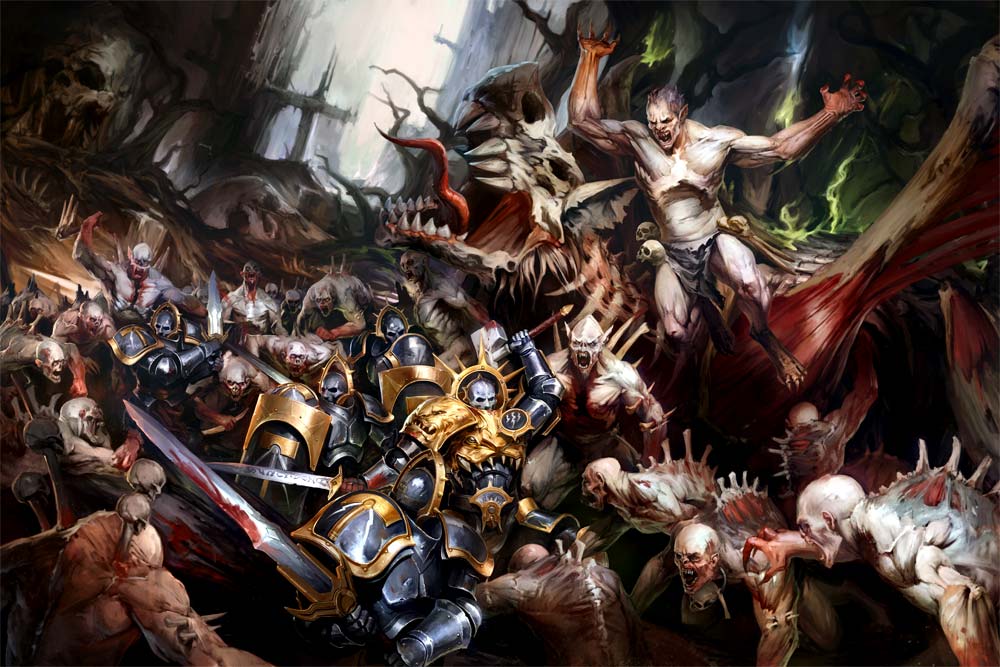


Great article, man. The way you create backgrounds and stories is amazing!